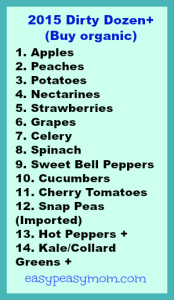2015 Dirty Dozen Fruits & Vegetables Cheat Sheet
Dirty dozen, clean fifteen, GMO, cage free…do you ever feel like the list of things that you need to watch out for at the grocery store can be longer than your actual grocery list? Yes? Oh good, I’m not the only one. I’ve been on a mission for a while now to create a healthier lifestyle for my family with the things we eat and the products we use. But not knowing where to start can make it easy to just not start at all. And if you decide you are going to start buying everything organic, well your wallet might be in for a huge shock. For me it is all about baby steps.
An Easy Change To Make
A relatively easy change that I made was figuring out what fruits and vegetables are important to buy organic and started with the ones that we buy regularly. Every year the Environmental Working Group (EWG) publishes a list of the “dirty dozen” and the “clean fifteen.” Basically it is the list they’ve put together of the fruits and veggies found to have the most and least pesticides.
Now, I’m not sure if it is because I usually have a super excited toddler with me when I’m at the grocery store (she LOVES it there, its weird) but when I am picking out my fruits and vegetables I always find myself staring at a potato or a pepper and wondering which list it’s on. The people who work there probably see me come in and think oh, there’s that confused girl again, always staring at the produce. So I created this handy-dandy printable cheat sheet of the dirty dozen list. (As you can see, there’s obviously more than twelve items on the list. I guess they couldn’t think of something catchy to go with fourteen). These are the fruits and vegetables that you’ll want to buy organic. You may feel like a bit of a nerd pulling it out of your wallet at the store, but hey, at least you won’t be the confused girl 🙂
Get your Dirty Dozen+ Printable here.
Farmer’s Markets are also a great place to stock up on local produce. Not only will you get more for your money, but you can speak directly to the people selling the produce to find out their farming practices. Buying local is not only a good way to support hometown and local farmers, it also means that your fruits and vegetables are spending less time in transit.
Quick tip: Regardless of whether you buy organic fruits and veggies, always give them a good rinse before eating. If you’re not buying organic, give them an extra good rinse with a combo of white vinegar and water. Mix equal parts white vinegar and water in a bowl. Soak your fruits and vegetables for a few minutes and then rinse them with cold water. The acid in the vinegar will help to kill the bacteria and break down the pesticide residue.
How do you make healthier food choices for your family? How has it impacted your grocery budget?

